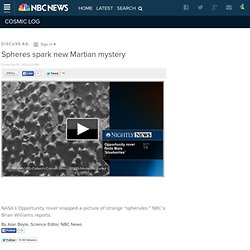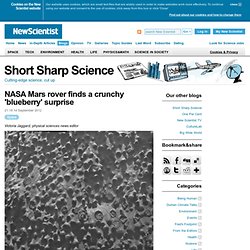

Spheres spark new Martian mystery. NASA's Opportunity rover snapped a picture of strange "spherules.

" NBC's Brian Williams reports. By Alan Boyle, Science Editor, NBC News Eight years ago, NASA's Opportunity rover came across strange-looking spheres that were nicknamed Martian blueberries — and now the Mars rover has sent back a picture showing a different flavor of berry that has the experts scratching their heads. "This is one of the most extraordinary pictures from the whole mission," Cornell astronomer Steve Squyres, the rover mission's principal investigator, said today in a news release. The golf-cart-sized Opportunity rover used the microscopic imager on the end of its robotic arm to take a super-close look at the spherical shapes. "Kirkwood is chock full of a dense accumulation of these small spherical objects," Squyres said. Iron-rich Martian blueberries first came to light soon after Opportunity headed out from its landing site on Mars' Meridiani Planum in early 2004.
Michael Howard Update for 12:30 a.m. Mystery Spheres on Mars Baffle Scientists. A strange picture of odd, spherical rock formations on Mars from NASA's Opportunity rover has scientists scratching their heads over what exactly they're looking at.

The new Mars photo by Opportunity shows a close-up of a rock outcrop called Kirkwood covered in blister-like bumps that mission scientists can't yet explain. At first blush, the formations appear similar to so-called Martian "blueberries" — iron-rich spherical formations first seen by Opportunity in 2004 — but they actually differ in several key ways, scientist said. ANALYSIS: Opportunity Rover (Almost) Rolls a Marathon "This is one of the most extraordinary pictures from the whole mission," said rover mission principal investigator Steve Squyres of Cornell University in Ithaca, N.Y., in a statement.
"Kirkwood is chock full of a dense accumulation of these small spherical objects. Mystery Spheres on Mars. ScienceCasts: The First Extraterrestrial Marathon. NASA Mars rover finds a crunchy 'blueberry' surprise. Victoria Jaggard, physical sciences news editor (Image: NASA/JPL-Caltech/Cornell Univ./ USGS/Modesto Junior College) NASA's Curiosity rover may be stealing all the headline of late, but lest it be forgotten, the veteran rover Opportunity is still turning up geologic gems.

A recent scan of rocky outcrops near the west rim of Endeavour Crater revealed a dense group of marble-sized spheres that have experts baffled. NASA scientists working on the Opportunity mission at first thought the spheres looked like structures known as Martian blueberries. These iron-rich orbs, discovered at the rover's landing site in 2004, are thought to have formed millions of years ago, when the Red Planet was likely warm enough to host liquid water. In some places minerals precipitated out of the water as it diffused through rock, leaving behind hard masses.
Similar spheres have been found in sandstones in the US Southwest, and some scientists think they may hold clues to finding microbial life on Mars. Biosignatures link microorganisms to iron mineralization in a paleoaquifer. Utah rocks help explain Martian "blueberries" - 16 June 2004. Rounded rocks in Utah may help explain the peculiar 'blueberries' that NASA's Opportunity rover found embedded in Martian bedrock.

Geologists studying the marble-sized rocks in the deserts of Southern Utah, US, say that these marbles must have formed in the same way as the ones on Mars. And they may provide a unique insight into early conditions on the Red Planet. The discovery of small spherical nuggets in Martian bedrock that look like "blueberries in a muffin" puzzled planetary scientists when Opportunity stumbled across them in February 2004. NASA determined that they are made of an iron-rich mineral called haematite and others pointed out that similar marbles were to be found on Earth.
Now Marjorie Chan and colleagues at the University of Utah in Salt Lake City have worked out how conditions on Earth determine the size and shape of the marbles, which begin to grow when iron-rich water seeps through bedrock. Fractures or faults But the ones on Mars are mainly spherical. (YouTube) Mars Exploration Rovers. Mars Rover Opportunity Reveals Geological Mystery.
NASA Mars Rover Opportunity Reveals Geological Mystery Small spherical objects fill the field in this mosaic combining four images from the Microscopic Imager on NASA's Mars Exploration Rover Opportunity.

Image credit: NASA/JPL-Caltech/Cornell Univ./ USGS/Modesto Junior College › Full image and caption › See image gallery PASADENA, Calif. -- NASA's long-lived rover Opportunity has returned an image of the Martian surface that is puzzling researchers. Puzzling Little Martian Spheres That Don't Taste Like 'Blueberries' Puzzling Little Martian Spheres That Don't Taste Like 'Blueberries' Small spherical objects fill the field in this mosaic combining four images from the Microscopic Imager on NASA's Mars Exploration Rover Opportunity.

The view covers an area about 2.4 inches (6 centimeters) across, at an outcrop called "Kirkwood" in the Cape York segment of the western rim of Endeavour Crater. The individual spherules are up to about one-eighth inch (3 millimeters) in diameter. The Microscopic Imager took the component images during the 3,064th Martian day, or sol, of Opportunity's work on Mars (Sept. 6, 2012).
For a color view of the Kirkwood outcrop as Opportunity was approaching it two weeks earlier, see PIA16128 . Home ● Cornell Astronomy. Astronomy.